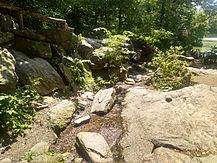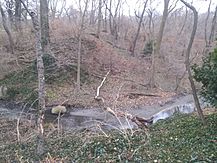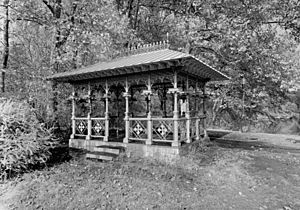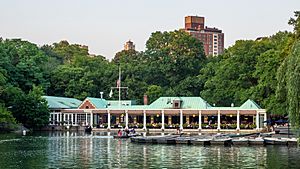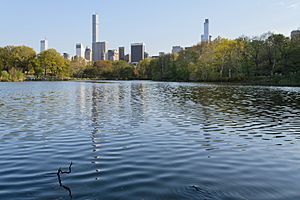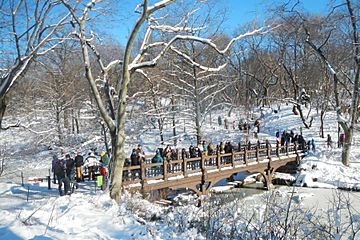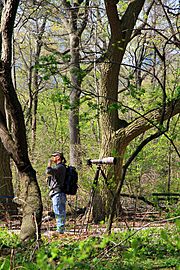The Ramble and Lake facts for kids
The Ramble and Lake are two amazing spots in Central Park in Manhattan, New York City. They were designed by Frederick Law Olmsted and Calvert Vaux in their 1857 Greensward Plan for the park. You can find them on the west side of the park, between 66th and 79th Streets.
The Ramble is a 38-acre (150,000 m2) forest area on the north side of the Lake. It has lots of hills, valleys, and winding paths. The New York City Department of Parks and Recreation calls it a protected nature preserve. It was made to be a "wild garden" where people could wander and enjoy nature, away from busy roads. The Ramble has several cool rustic bridges and used to have a small cave.
The Lake is a winding 20-acre (81,000 m2) body of water. It has many natural plants, rocky areas from ancient glaciers, and small open grassy spots. A stream called the Gill flows into the Lake through Azalea Pond. At the northwest corner of the Lake, the ground rises to Vista Rock, where you'll find Belvedere Castle. The western shore has the Ladies' Shelter, the southern shore has Bethesda Terrace, and the eastern shore has the Loeb Boathouse.
Contents
Exploring the Ramble and Lake
The Ramble: A Wild Forest Oasis
The Ramble is one of three main woodlands in Central Park. It covers about 36 to 38 acres (14.6 to 15.4 ha) and is full of winding paths, rocky spots, and charming bridges. The New York City Department of Parks and Recreation has named the Ramble a "Forever Wild" natural preserve. This means it will always stay a natural area and cannot be developed in the future.
When the park was built, many different native trees were planted here. These included trees like tupelo, American sycamore, and various types of oaks. They were arranged to create a colorful, almost tropical look. Some trees not native to the area, like Kentucky coffee trees and yellowwoods, were also planted. Today, you can still see many beautiful trees in the Ramble.
The Lake and Its Waterways
The Lake covers 20 acres (8.1 ha) and was created from swampy ground. It was dug out entirely by hand! The Lake is connected to two other water areas. The Gill, which means "stream" in Scottish, starts from a water pipe in the Ramble. It flows southeast into Azalea Pond, a popular spot for birdwatchers. There's also an inlet called Bank Rock Bay at the very north end of the Lake.
There used to be a Ladies' Skating Pond next to the western side of the Lake. It was partly filled in during 1888 for health reasons. By 1936, it was completely drained. Today, this area is a grassy lawn and a dog walk, lower than the surrounding land.
Cool Places to See
Bethesda Terrace and Fountain
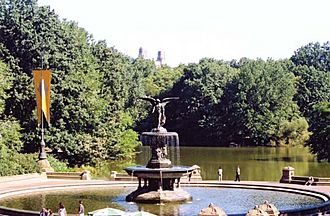
Bethesda Terrace and Fountain are located at the southeast end of the Lake. They mark the northern end of the Central Park Mall, which was a key part of the park's original Greensward Plan. The terrace has two levels, and the lower level holds the famous fountain. In the center of the fountain is a sculpture called Angel of the Waters (1873). It was created by Emma Stebbins, who was the first American woman to get a big public sculpture project.
Bridges of the Park
There are many bridges in the Ramble, including one that crosses the Lake. Bow Bridge connects the Lake's southern shore to the Ramble on the northern shore. This bridge is known for its beautiful iron design. It's 87 feet (27 m)*, making it the longest bridge in the park. Bow Bridge was fixed up in 1974.
The northern end of the Lake has a small bridge called Oak Bridge or Cabinet Bridge. It crosses Bank Rock Bay, so it's also called Bank Rock Bridge. The original bridge was made of wood. It was replaced in 1935, and again in 1982 and 2009. The stone parts of the bridge are from the original design.
You'll also find three smaller bridges in the Ramble. One is the Ramble Arch, a stone arch that carries one walking path over another. The Gill Bridge, made of wood, crosses the Gill stream where it begins. Another unnamed wooden bridge is located further up the Gill stream.
The Ramble Cave
A cave used to be located inside the Ramble, near Ramble Arch. It wasn't part of the original park plan. It was a narrow space found after digging up some soil. Olmsted and Vaux added big rocks at the entrance and built stone stairs leading down into it.
The Ramble Cave, also known as Indian Cave, was a very popular spot. However, it was sealed off by 1934.
Hernshead and Ladies' Pavilion
On the western shore of the Lake, between 75th and 77th Streets, there's a rocky area called the Hernshead. It means "heron's head" because the rock looks a bit like a heron's head. This spot was restored in 1987. A building called the Ladies Cottage used to be here. It was next to the Ladies' Skating Pond and might have been a changing room for women skaters.
The Ladies' Pavilion, a pretty iron shelter, was later moved to the Hernshead. Jacob Wrey Mould designed it in 1871 as a shelter for people waiting for streetcars. After some time, the pavilion was moved to the Hernshead. The exact date it was moved is not clear, but it was sometime between 1904 and the 1930s. The Ladies' Pavilion got damaged over time, but it was fully restored in 1979 with help from donations.
Loeb Boathouse: Boats and Bites
The Loeb Boathouse, on the eastern shore of the Lake, is one of several places where boats have been rented on the Lake. Boating became popular in the early 1860s. A Victorian-style boathouse was finished by 1873 or 1874. However, it fell apart and was destroyed by 1950.
A new boathouse was built in 1954, thanks to a large donation from businessman Carl M. Loeb. In 1983, the boathouse was updated, and a restaurant opened inside. Today, the Loeb Boathouse has a dining room, outdoor eating areas, and places to buy snacks. You can also rent rowboats there!
Other Nearby Structures
Vista Rock is on the northwest corner of the Lake, near 79th Street. It's 130 feet (40 m) high, making it the second-highest point in Central Park. On top of the rock is Belvedere Castle, a fun building constructed between 1869 and 1871. It was used as a weather station from 1919 to 1960. Now, Belvedere Castle is a visitors' center.
The Swedish Cottage Marionette Theatre is just northwest of the Lake. This building was made in Sweden and shipped to the U.S. for an exhibition in 1876. It was later moved to Central Park. Since 1947, it has been home to one of the last marionette (puppet) companies in the country.
Strawberry Fields, a 2.5-acre (1.0 ha) memorial, is southwest of the Lake. It honors Beatles member John Lennon, who lived nearby and was sadly killed. The memorial was created in 1981 and rebuilt in 1985. Its most famous part is the "Imagine" mosaic in the center.
History of the Ramble and Lake
Building the Park's Features
The Ramble and Lake were among the first parts of Central Park to be built. They formed the northern end of the Central Park Mall. The Lake was created from part of the Sawkill Creek, a natural stream that flowed through the park area. To make the Lake, the stream was blocked with a large earth dam.
In August 1857, after Central Park's construction was approved, workers started building fences, clearing land, and leveling the ground. The Lake was finished first, partly because it was filled with water drained from the Ramble. It opened to the public for ice skating in December of that year. The Lake was seven feet deep in the center, with shallower edges for safety. The Ramble opened officially in June 1859. Both the Ramble and Lake quickly became very popular with visitors.
The park's original plan included a place for music. The first concert in Central Park happened in the Ramble on July 6, 1859. Later, concerts also took place on the Lake. However, concerts in the Ramble didn't last long. A concert area was built in the Mall, and by 1865, most concerts moved there.
Park Changes and Updates
Over time, the care of the Ramble and Lake, like the rest of the park, became less strict in the early and mid-1900s. In 1927, Mayor Jimmy Walker asked a landscape designer named Herman W. Merkel to check the park and suggest improvements. Merkel noted that the Ramble had many dead plants and trees.
Some structures were closed or taken down. The Cave was closed by 1934. The old boathouse on the Lake was closed in 1950 and replaced in 1954. By 1971, the Ladies' Pavilion was also damaged, but it was replaced two years later.
Bringing the Park Back to Life
The Ramble was partly restored in the late 1900s. These updates began with the Ladies' Pavilion, which was brought back to its original look in 1979. In 1981, the Central Park Conservancy cleared some trees in the Ramble to let in more sunlight. The Gill stream was also approved for restoration in 1982.
The Central Park Conservancy started fixing up the Lake's shoreline in 2006. This project aimed to make the Lake better for nature and more beautiful. They removed unwanted plants and replanted the area around the northern end of the Lake with native shrubs and trees.
Bank Rock Bridge was rebuilt in 2009, using its original materials and following Calvert Vaux's design from 1859–60. The new bridge is made of steel with decorative iron parts and a wooden deck.
The waterfall where the Gill stream flows into the Lake was also rebuilt. It was designed to look like its dramatic original form. Parts of the Lake were cleaned of built-up dirt. An island that used to be in the Lake, which had worn away, was rebuilt in 2007 with strong rocks and new plants that love water.
Birdwatching in the Ramble
The Ramble is one of the best places for birdwatching in Central Park. Over the years, more than 250 different kinds of birds have been seen here! This includes over 20 types of warblers that fly through during their spring and fall migrations in April and October. Azalea Pond, by the water, is a very popular spot for birdwatchers.
If you bring a dog to the Ramble, it must be on a leash at all times.
Images for kids
-
East end of the Lake and Loeb Boathouse, seen from Bethesda Terrace


